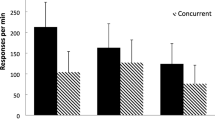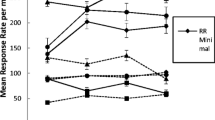Abstract
Theoretical and empirical studies of schedule-induced behavior in humans are examined. As there is no terminological consensus in the field, a set of terms is defined, based on suggestions from several authors.
Methodological problems in existing research are highlighted, with special regard to the choice of baseline schedules of reinforcement in experiments. In a majority of studies where researchers claim to have found schedule-induced behavior in humans it is highly doubtful whether this is the case, because inadequate baseline schedules have been used.
Similar content being viewed by others
References
ALLEN, J. D., & WEIDINGER, R. C. (1980). Truly random reinforcement intervals do produce schedule-induced polydipsia. Bulletin of the Psychonomic Society, 16, 175.
BROWN, P. L, & JENKINS, H. M. (1968). Auto-shaping of the pigeon’s key-peck. Journal of the Experimental Analysis of Behavior, 11, 1–8.
BRYANT, W. E., & PORTER, J. H. (1983). A comparison of schedule-induced wheel running in rats, hamsters, gerbils, and guinea pigs. Bulletin of the Psychonomic Society, 21, 311–314.
BUSKIST, W. F., MILLER, H. L, Jr., & BENNETT, R. H. (1980). Fixed-interval performance in humans: Sensitivity to temporal parameters when food is the reinforcer. The Psychological Record, 30, 111–121.
CAMPAGNONI, E R., COHEN, P. S., & YOBURN, B. C. (1981). Organization of attack and other behaviors of White King pigeons exposed to intermittent water presentations. Animal Learning & Behavior, 9, 491–500.
CHEREK, D. R. (1982). Schedule-induced cigarette self-administration. Pharmacology Biochemistry & Behavior, 17, 523–527.
COHEN, P. S., & LOONEY, T. A. (1984). Induction by reinforcer schedules. Journal of the Experimental Analysis of Behavior, 41, 345–353.
DOYLE, T. F., & SAMSON, H. H. (1985). Schedule-induced drinking in humans: A potential factor in excessive alcohol use. Drug and Alcohol Dependence, 16, 117–132.
DOYLE, T. F., & SAMSON, H. H. (1988). Adjunctive alcohol drinking in humans. Physiology and Behavior, 44, 775–779.
EPLING, W. F., PIERCE, W. D., & STEFAN, L. (1983). A theory of activity-based anorexia. International Journal of Eating Disorders, 3(1), 27–45.
FALK, J. L. (1961). Production of polydipsia in normal rats by an intermittent food schedule. Science, 133, 195–196.
FALK, J. L. (1971). The nature and determinants of adjunctive behavior. Physiology and Behavior, 6, 577–588.
FALK, J. L. (1977). The origin and functions of adjunctive behavior. Animal Learning & Behavior, 5, 325–335.
FALK, J. L. (1986). The formation and function of ritual behavior. In T. Thompson & M. D. Zeiler (Eds.), Analysis and integration of behavioral units (pp. 335–355). Hillsdale, NJ: Lawrence Erlbaum.
FALK, J. L., & TANG, M. (1988). What schedule-induced polydipsia can tell us about alcoholism. Alcoholism: Clinical and Experimental Research, 12, 577–585.
FALLON, J. H., Jr., ALLEN, J. D., & BUTLER, J. A. (1979). Assessment of adjunctive behaviors in humans using a stringent control procedure. Physiology & Behavior, 22, 1089–1092.
FANTINO, E., & LOGAN, C. A. (1978). The experimental analysis of behavior. San Francisco: Freeman.
FOSTER, W. S. (1978). Adjunctive behavior: An underreported phenomenon in applied behavior analysis? Journal of Applied Behavior Analysis, 11, 545–546.
FREDERIKSEN, L. W., & PETERSON, G. L (1974). Schedule-induced aggression in nursery school children. The Psychological Record, 24, 343–351.
FRICCHIONE, G., KELLEHER, S., & AYYALA, M. (1987). Coexisting central diabetes insipidus and psychogenic polydipsia. Journal of Clinical Psychiatry, 48, 75–76.
GRANGER, R. G., PORTER, J. H., & CHRISTOPH, N. L. (1984). Schedule-induced behavior in children as a function of interreinforcement interval length. Physiology & Behavior, 33, 153–157.
HARRELL, W. A. (1972). Effects of extinction on magnitude of aggression in humans. Psychonomic Science, 29, 213–215.
HAYES, S. C., BROWNSTEIN, A. J., ZETTLE, R. D., ROSENFARB, I., & KORN, Z. (1986). Rule-governed behavior and sensitivity to changing consequences of responding. Journal of the Experimental Analysis of Behavior, 45, 237–256.
HAYES, S. C., KOHLENBERG, B. S., & MELANCON, S. M. (1989). Avoiding and altering rule-control as a strategy of clinical intervention. In S. C. Hayes (Ed.), Rule-governed behavior (pp. 359–385). New York: Plenum Press.
HOPPMANN, R. A., & ALLEN, J. D. (1979). A test of the generality of schedule induced polydipsia to wild caught Norway rats. Physiology & Behavior, 22, 379–381
KACHANOFF, R., LEVEILLE, R., McLELLAND, J. P., & WAYNER, M. J. (1973). Schedule induced behavior in humans. Physiology & Behavior, 11, 395–398.
KAZDIN, A. E. (1973). The failure of some patients to respond to token programs. Journal of Behaviour Therapy & Experimental Psychiatry, 4, 7–14.
KEEHN, J. D. (1985). Concurrent acquisition and maintenance of schedule-induced licking and biting by two strains of rats. The Psychological Record, 35, 559–574.
KELLY, J. F., & HAKE, D. F. (1970). An extinction-induced increase in an aggressive response with humans. Journal of the Experimental Analysis of Behavior, 14, 153–164.
LEFRANCOIS, G. R. (1980). Psychology Belmont, Ca: Wadsworth.
LINDMAN, R. (1982). Social and solitary drinking: Effects on consumption and mood in male social drinkers. Physiology & Behavior, 28, 1093–1095.
LOONEY, T. A., & COHEN, P. S. (1982). Aggression induced by intermittent positive reinforcement. Biobehavioral Reviews, 6, 15–37.
LOONEY, T. A., & MCCLURE, J. T. (1981). A comparison of schedule-induced attack in White King and White Carneaux pigeons. Bulletin of the Psychonomic Society, 18, 133–134.
LORENZ, K. (1967). On aggression. London: Methuen.
MOR, F., MOR-SNIR, I., & WYSENBEEK, A. J. (1987). Rhabdomyolysis in self-induced water intoxication. The Journal of Nervous and Mental Disease, 175, 742–743.
MEICHENBAUM, D., & CAMERON, R. (1982). Cognitive-behavior therapy. In G. T. Wilson & C. M. Franks (Eds.), Contemporary behavior therapy (pp. 310–338). New York: Guilford Press.
MÜLLER, P. G., CROW, R. E., & CHENEY, C. D. (1979). Schedule-induced locomotor activity in humans. Journal of the Experimental Analysis of Behavior, 31, 83–90.
OEI, T. P. S., & SINGER, G. (1979). Effects of a fixed time schedule and body weight on ethanol self-administration. Pharmacology, Biochemistry & Behavior, 10, 767–770.
OVERSKEID, G. (1987). Aspekter ved skjema-indusert adferd [Aspects of schedule-induced behavior]. Diskriminanten, 14(3), 5–42.
PORTER, J. H., BROWN, R. T., & GOLDSMITH, P. A. (1982). Adjunctive behavior in children on fixed interval food reinforcement schedules. Physiology & Behavior, 28, 609–612.
PORTER, J. H., HASTINGS, M. T., Jr., PAGELS, J. F. (1980). Schedule-induced polydipsia in the cotton rat (Sigmodon hispidus). Bulletin of the Psychonomic Society, 16, 15–18.
PRIOR, M., WALLACE, M., & MILTON, I. (1984). Schedule-induced behavior in hyperactive children. Journal of Abnormal Child Psychology, 12, 227–244.
ROPER, T. J. (1981). What is meant by the term “schedule-induced,” and how general is schedule induction? Animal Learning & Behavior, 9, 433–440.
ROUBICEK, C. B., & RAY, D. E. (1969). Genetic selection for adipsia and polydipsia in the rat. Journal of Heredity, 60, 332–335.
RUSHEN, J. (1984). Stereotyped behaviour, adjunctive drinking and the feeding periods of tethered sows. Animal Behaviour, 32, 1059–1067.
SKINNER, B. R, & MORSE, W. H. (1957). Concurrent activity under fixed-interval reinforcement. The Journal of Comparative and Physiological Psychology, 50, 279–281.
SPIGA, R., ZEICHNER, A., & ALLEN, J. D. (1986). Human schedule-induced cardiovascular response. Physiology & Behavior, 36, 133–140.
STADDON, J. E. R. (1977). Schedule-induced behavior. In W. K. Honig & J. E. R. Staddon (Eds.), Handbook of operant behavior (pp. 125–152). Englewood Cliffs, NJ: Prentice-Hall.
STADDON, J. E. R., & AYRES, S. L. (1975). Sequential and temporal properties of behavior induced by a schedule of periodic food delivery. Behaviour, 54, 26–49.
STADDON, J. E. R., & SIMMELHAG, V. (1971). The “superstition” experiment: A reexamination for the principles of adaptive behavior. Psychological Review, 78, 3–43.
TAKAHASHI, M., & IWAMOTO, T. (1986). Human concurrent performances: The effects of experience, instructions, and schedule-correlated stimuli. Journal of the Experimental Analysis of Behavior, 45, 257–267.
TODD, J. T., MORRIS, E. K., & FENZA, K. M. (1989). Temporal organization of extinction-induced responding in preschool children. The Psychological Record, 39, 117–130.
VIEWEG, W. V. R., DAVID, J. J., ROWE, W. T., PEACH, M. J., VELDHUIS, J. D., KAISER, D. L, & SPRADLIN, W. W. (1985). Psychogenic polydipsia and water intoxication - concepts that have failed. Biological Psychiatry, 20, 1308–1320.
WALLACE, M., & OEI, T. P. S. (1981). Differences in schedule induced behaviour as a function of reinforcer in humans. Physiology & Behavior, 27, 1027–1030.
WALLACE, M., SANSON, A., & SINGER, G. (1978). Adjunctive behavior in humans on a food delivery schedule. Physiology & Behavior, 20, 203–204.
WALLACE, M., & SINGER, G. (1976). Adjunctive behavior and smoking Induced by a maze solving schedule in humans. Physiology & Behavior, 17, 849–852.
WALLACE, M., SINGER, G., WAYNER, M. J., & COOK, P. (1975). Adjunctive behavior in humans during game playing. Physiology and Behavior, 14, 651–654.
ZUBENKO, G. S. (1987). Water homeostasis in psychiatric patients. Biological Psychiatry, 22, 121–125.
Author information
Authors and Affiliations
Additional information
The preparation of this article was supported in part by a grant from The Norwegian Work Life Center. Thanks are due to Per Saugstad and Andrew Hutter for helpful comments.
Rights and permissions
About this article
Cite this article
Overskeid, G. Is Any Human Behavior Schedule-Induced?. Psychol Rec 42, 323–340 (1992). https://doi.org/10.1007/BF03399605
Published:
Issue Date:
DOI: https://doi.org/10.1007/BF03399605




